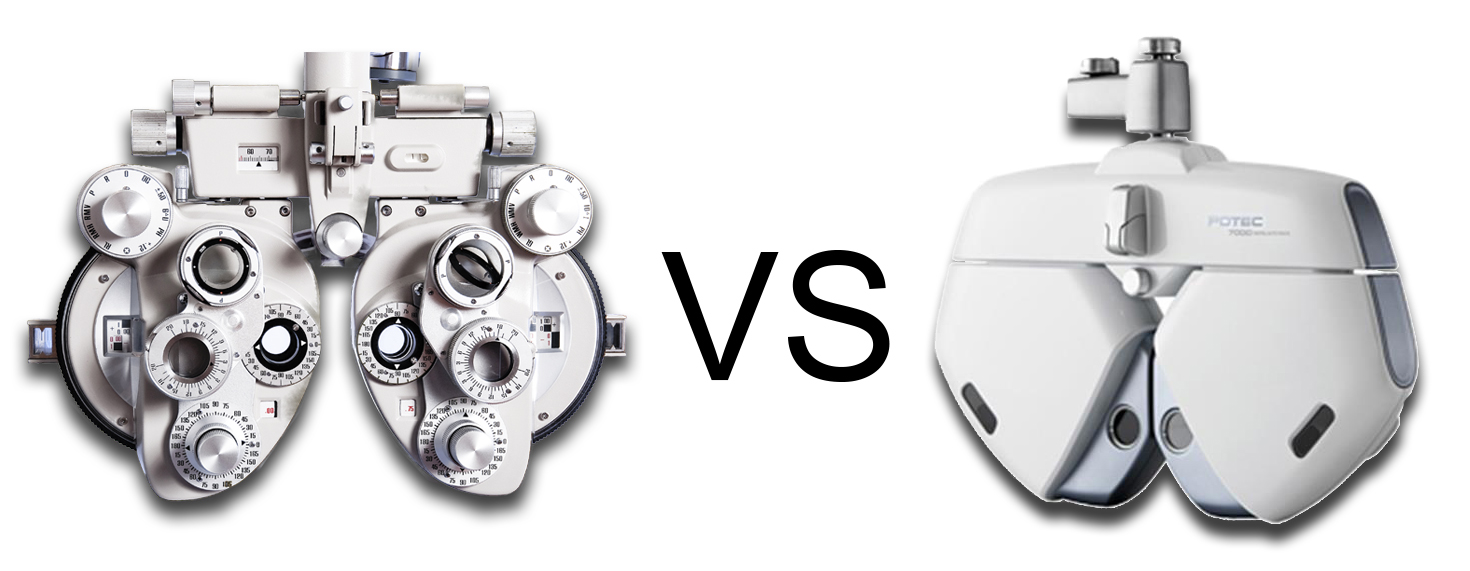
In the ophthalmic industry, we have a habit of referring to all refraction systems—both manual and digital—as “phoropters;” however, technology has advanced in recent years, and with the shift to digital systems, there is now a major difference between manual and digital refractors.
What Makes Manual and Digital Refractors Similar
Manual and digital refractors are both tools used to detect and correct refractive error by determining patient prescriptions. Veatch even created a full history and guide of the refractor system.
Both manual and digital systems require highly trained, educated and experienced ophthalmic professionals to conduct the refraction test. However, the three primary components of manual and digital refractors are quite different:
1. Data Entry
Manual Refractors:
Data collected during the patient’s pretest is manually entered into both the refractor and the patient’s record.
Digital Refractors:
With system integration, all data is automatically synched to each piece of equipment and recorded to the patient’s digital file, completely eliminating multiple entries.
2. Lens Combinations
Manual Refractors:
A typical refraction exam with a manual refractor involves the following steps for each eye:
- Sphere. Manually adjust the lens 1/4 above one and below two, switching between the options to receive the patient’s feedback.
- Axis. Pull the cross-cylinder down and line up prism knobs to read the patient’s axis.
- Cylinder: Twist the cross-cylinder to check for astigmatism. The power marks should align with the axis.
- Recheck Sphere.
Each of these steps requires manual knob adjustments.
Digital Refractors:
Digital refractors follow the same process as manual—except these adjustments are controlled from one digital panel. So, ophthalmic professionals can stay seated in one place and focus on speaking directly to the patient. Once the right combination has been selected, the prescription is automatically updated and saved to the patient’s file from the digital system—no more repetitive entries.
3. Parts
Manual Refractor:
Each knob on these systems are adjusted manually to asses the patient’s prescription, including:
- Aperture control
- Shere power
- Cylinder power
- Cylinder axis
- Jackson cross cylinder
- Risley prisms
Digital Refractor:
The components of digital refractors utilize the same diagnostic parts, such as cylinder power and sphere power, but are controlled with more advanced technology, including:
- Electronic driven refractor head used to display powered lenses to the patient
- Software panel that changes the lenses in the refractor head and controls data entry
- Autorefractor to measure the objective refractive error
- Autolensmeter to measure the powers of the patient's current prescription
Digital Refractors’ Additional Capabilities
Digital systems have more features, which means these pieces of equipment can do things manual systems can’t.
Digital refractors, for example, have a dual cross cylinder. So, when testing for astigmatism, the digital refractor presents a split prism to patients. Normally, you have to manually flip the images back and fourth for the patient to provide feedback. With dual cross, the images are presented at same time, minimizing your exam time.
Additionally, the auto lensometer takes a reading from the patient’s current glasses prescription and puts it into digital refractor system. When the patient’s final, updated prescription is prescribed, the ophthalmic doctor can compare the old prescription to new one at the end of the exam. Now, patients are much more likely to update their prescription by seeing the difference immediately.
EMR Integration
According to government mandate, all doctors are required to convert paper records to electric in order to increase transparency (source). Digital refraction systems make filling out forms easier than ever by collecting data throughout exams and minimizing multiple entries.
Digital Refractors: New Technology, the New Industry Standard
It’s already been proven: digital refractors increase efficiency, improve patient satisfaction and reduce physical discomfort for the doctor. With increased capabilities and connected equipment, there are far fewer errors and a high return on investment. In fact, switching to a digital refractor allows doctors to see two to six more patients per day (source).
Update Your Office
Did you know manual refractors today still use 1950s technology? If making the switch to a digital system seems a little daunting, it’s time to learn more about going digital. The benefits and return on investment make it clear as to why the industry is leaving manual systems behind and switching to digital.
Learn Everything You Need to Know About Digital Refractors
Or, contact us today for a free consultation.